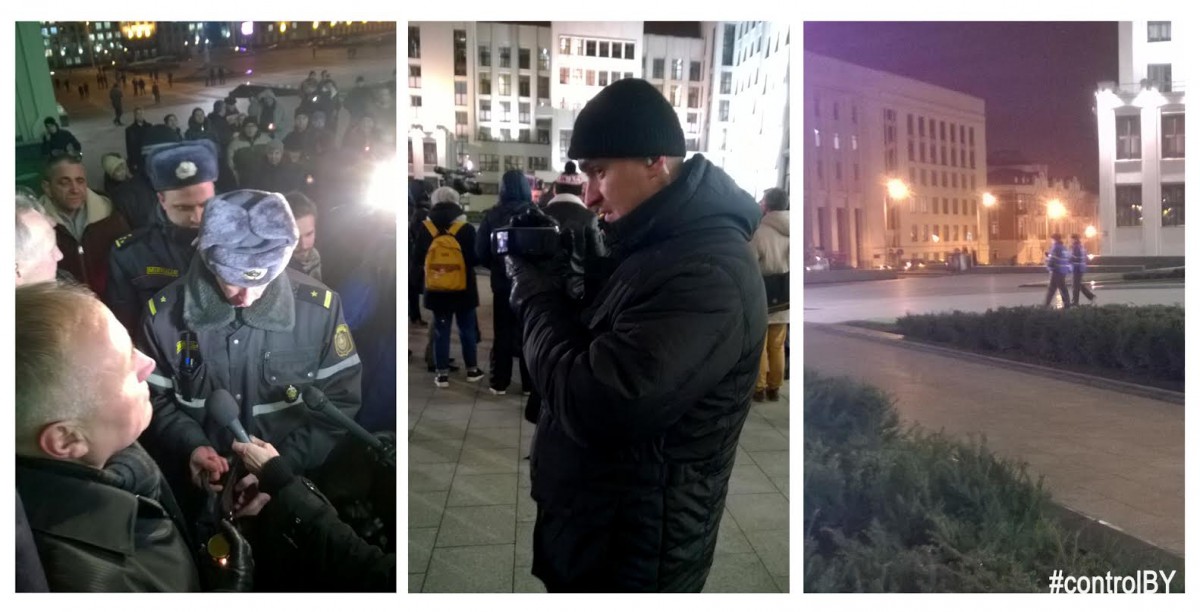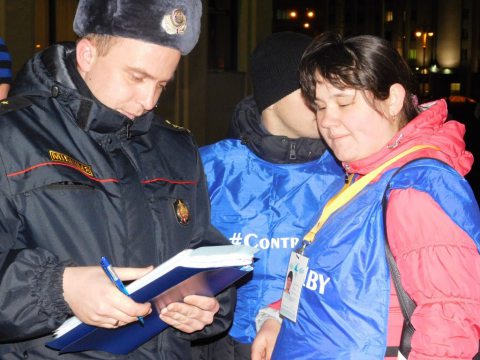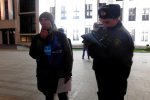Report on the results of monitoring of a mass event on November 24 in Minsk dedicated to the anniversary of the referendum of 1996
Report on the results of monitoring of a mass event on November 24 in Minsk dedicated to the anniversary of the referendum of 1996
Conclusions
The street action in Minsk dedicated to the anniversary of the referendum of 1996 and commemorating the abducted politicians of the end of the 1990’s was of peaceful character. The absence of an application for holding mass actions, as required by law, is not a reason to limit the freedom of peaceful assembly.
The negative practice of drawing up reports of an administrative offense against organizers and participants of the street action, without detentions, was also extended to journalists and observers. There have been 12 administrative reports compiled on the venue, including three against journalists and two against observers who were regarded as participants of the action. The fact can be estimated as a large-scale operation of administrative prosecution of any person present at mass events in any capacity.
As earlier, the majority of the police following the action were dressed in plain clothes which does not allow identifying them. The number of plain-clothed people and employees with video cameras increased, which looks quite disproportionate to the number of the participants of the action and the character of the procession.
The positive aspect was presence of an informational group from the police and their communicability with the observers, however, they appeared on the venue only after the procession ended and answered rather in the form of opinions.
Monitoring Methodology
The Belarusian Helsinki Committee and the Human Rights Center "Viasna" have been carrying out systematic monitoring of public events in Minsk for several years already, being guided by their own methodology for monitoring, which includes the recruitment and training of observers regarding the principles of public control, standards of peaceful assembly and monitoring methodology; filling out the questionnaire during the monitoring on the spot; procession of the questionnaires and writing the monitoring report. The observation questionnaires have been developed jointly by the human rights organizations and include questions regarding the possibility of implementing the functions by observers and the media, the behavior of the organizers and participants of the mass event and the police, as well as the presence of ambulance cars. Observers are admitted to watching only if they agree to comply with the rules and principles of observation (independence and political neutrality; description of the facts, not opinions; non-interference in the event, which is being monitored; commitment to the principles of law; rejection of all forms of violence and discriminatory practices; correct behavior). During the execution of their duties observers keep separately from the action participants. They are marked designated with badges and blue vests.
Background Information
As reported in mass media, Mikalai Statkevich invited to hold a procession from the main universal store GUM, by the building of the Ministry of Home Affairs, on November 24, 2015 to mark the anniversary of the referendum of 1996 and to commemorate the abducted politicians Jury Zakharanka and Viktar Hanchar.
The mass event on November 24, 2015 was monitored fully and in person by six observers who had been trained and marked accordingly.
The Course of the Mass Action
- The action gathered near GUM and processed on the pavements of Independence Avenue to Independence Square and the building of the Central Electoral Committee in Minsk.
- The number of participants of the action was from 80 at the place of gathering up to 110 at the place of demonstration.
- The number of police officers was hard to identify because most of them were dressed in civilian clothes. The number of traffic policemen was around 7 people, policemen dressed in uniform – four people, policemen dressed in blue vests signed “Informational group” – 2 people, around 60 representatives from law enforcement agencies were dressed in civilian clothes (remarkable features: carrying ear plugs and walkie-talkies). All senior officials from the main department of home affairs of the Minsk City Executive Committee and local district police departments were dressed in civilian clothes and had no identification marks. The police officers present had rubber truncheons and communication means. Around 10 plain-clothed officers were taking video recording of the action. A man was noticed with an electroshock gun in hands.
- Special equipment noticed: a car of the traffic police.
- There were no obstructions for the procession to get to the place of demonstration.
- Work of the media and observers during the mass event was not obstructed; however, after that, reports of administrative offense were drawn up against three journalists and two observers, as if they participated in an unsanctioned mass event.
- There were no calls for violent actions noticed from participants of the action.
- The participants used icon lamps and the following placards and banners: portraits of Hanchar and Zakharanka with the sign “Belarus Remembers”, portraits of four abducted people with the sign “The fate worries Belarus!”, the banner with the sign “I demand capital punishment for Lukashenko”.
- The following symbols were used: white-red-white flags with Pahonia – one on a flag stoke, two on shoulders or of small sizes in hands.
- The slogan Long Live Belarus was chanted.
- There were no demands towards the participants from organizers of the action; all demands from law enforcement agencies were observed (to stop at red traffic light).
- No physical force was applied by the police during the mass event. The informational group willingly communicated, answered questions, but failed to explain why attitude to observers had changed.
- The procession was split into parts at traffic lights when traffic police gave whistle signals.
- Observers did not see any ambulance car.
- At the end of the demonstration, near CEC building, reports of administrative offenses were drawn up against Mikalai Statkevich, Uladzimir Niakliayeu, Maksim Viniarski, Ales Makayeu, Antos Zhylko, Stanislau Paulinkovich, Andrei Davidovich, journalists Dzmitry Halko (Novy Čas), Halina Abakunchyk (Radio Svaboda), Katsiaryna Andreyeva (Narodnaja Volya), observers from BHC and Viasna Siarhiei Kaspiarovich and Natallia
Recommendations:
To organizers:
- To regulate movement of the procession column, to minimize splits in the procession after crossing the carriageway;
To law enforcement agencies:
2) to stop the practice of administrative prosecution of participants, journalists and human rights defenders during mass events, to stop administrative prosecution of Mikalai Statkevich, Uladzimir Niakliayeu, Maksim Viniarski, Ales Makayeu, Antos Zhylko, Stanislau Paulinkovich, Andrei Davidovich, as they have exercised their right to peaceful assembly, guaranteed by article 35 of the Constitution of the Republic of Belarus, and by articles 19 and 21 of the International Covenant on Civil and Political Rights, and other international treaties in the sphere of human rights, and also to stop administrative prosecution against journalists Dzmitry Halko (Novy Čas), Halina Abakunchyk (Radio Svaboda), Katsiaryna Andreyeva (Narodnaja Volya), observers from BHC and Viasna Siarhiei Kaspiarovich and Natallia Satsunkievich, as they were performing their professional duties at the mass event, which is not a violation.
3) to secure the public order during mass events wearing the uniform, as well as being designated with identification cards (badges or breast signs);
4) to secure uninterrupted movement of the column of participants at crossroads, by restraining the traffic.
To legislators and entities with legislative initiative:
5) to initiate amendments to the legislation to bring it into line with international standards on freedom of peaceful assembly.





















